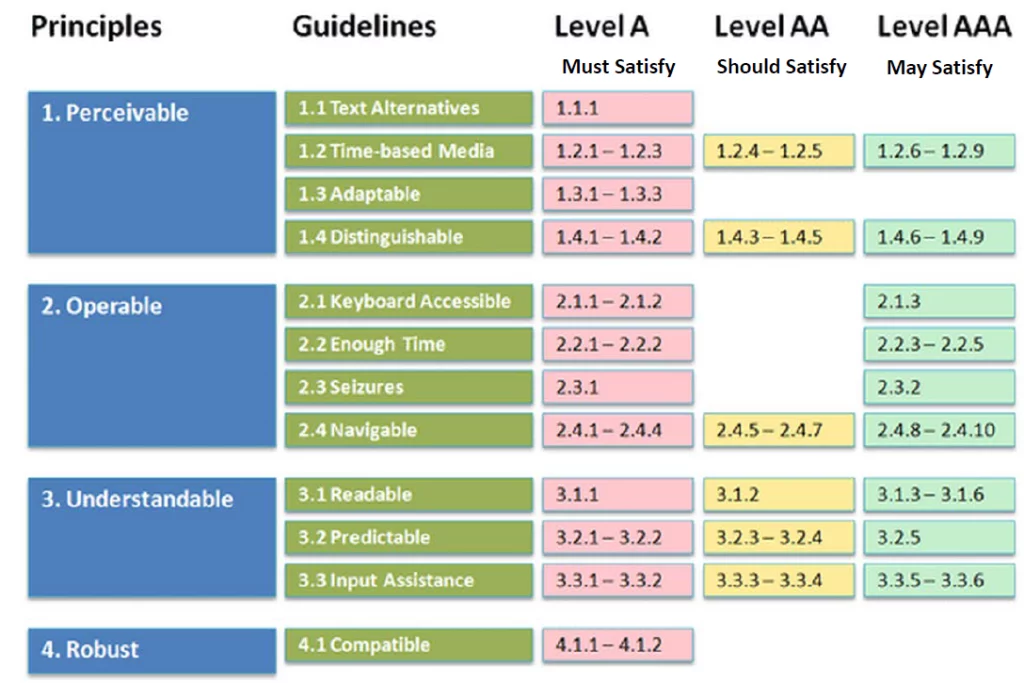A Comprehensive Guide to Digital Accessibility for Local Government
Your comprehensive guide to ensuring ADA-compliant digital content.
Your municipality does not merely care about all its residents as a collective body of voters. It cares about each resident as a unique individual with personal goals, opinions, and needs. To ensure equitable access to local information and digital resources for its residents , your community has committed to meeting and exceeding accessibility standards as set forth by the Americans with Disabilities Act (ADA), yet the rules and requirements are changing, and it is your job to ensure ongoing compliance.
What is Digital Accessibility
“Accessibility” as it relates to the Americans With Disabilities Act, refers to providing equal access to individuals with disabilities. Relative to digital accessibility, civic leaders must think about the accommodations needed for people experiencing barriers of access due to vision, hearing, or mobility disabilities when consuming digital technology.

Title III of the ADA prohibits “discrimination on the basis of disability in the activities of places of public accommodations.” Today that includes the Internet, which means “accessibility” poses a much more significant issue, and, like the Internet itself, impacts a much larger population. As much as 15 percent of the world’s population has a disability that may prevent them from obtaining equal access to digital content. Many disabled individuals use assistive technology to assist them in utilizing computers and accessing digital content. Common forms of assistive technology include screen readers, optical character recognition (OCR) software systems, magnification software, and voice recognition tools.
What Does “Digital Accessibility Compliance” Mean?
In general, “compliance” as it relates to digital accessibility refers to adherence to regulations and laws. As it relates to legal demand letters relating to digital accessibility, “compliance” refers to the actions an entity takes to address or comply with demands.
What Does “Conformance” Mean?
As it relates to digital accessibility, “conformance” refers to the accordance of digital materials with ADA-related digital accessibility requirements. The level of conformance required is dependent on the entity.
What is the ADA?
The Americans with Disabilities Act, or ADA, grew out of the Civil Rights Movement of the 1960s. However, the law did not address discrimination against people with disabilities until Section 504 of the Rehabilitation Act of 1973 became law. The ADA was signed into law by George H.W. Bush on July 26, 1990. Since then, advocacy groups representing millions of Americans and people around the world, who are prevented from equal access both in the physical and digital world, have fought to make the world more inclusive and guarantee the rights of individuals under the law.
Title II and Title III
Title II of the Americans with Disabilities Act is a regulation which prohibits discrimination against people with disabilities by public entities, state, or local government, and any of their departments, agencies, or other instrumentalities. The Federal Government is not considered a public entity and is covered under Section 508 of the Rehabilitation Act of 1973. ADA Title III is a regulation which prohibits discrimination on the basis of disability in the activities of places of public accommodations, which includes the Internet.
Representing Compliance
Municipalities can publicly reflect their compliance by marketing their commitment on their website. Municipalities can accomplish this compliance step by the addition of:
- An accessibility statement posted on their website
- Earning an accessibility certification
- Partnering with an automation remediation partner to ensure ongoing compliance and auditing
The Latest Changes to Section 508
Section 508 of the Rehabilitation Act of 1973 is a Law that requires Federal agencies to make their electronic and information technology (EIT) accessible to people with disabilities. Section 508 was added in 1998 to keep up with the increasing use of the Internet in public institutions. Section 508 applies to the Federal Government, but there may be implications for employees and others at the state level. Many states have also passed legislation requiring Electronic and Information Technology (EIT), also known as Information and Communication Technology (ICT) accessibility.
On January 18, 2017, The Architectural and Transportation Barriers Compliance Board (Access Board) issued a final rule that updates accessibility requirements for ICT in the federal sector covered by Section 508 of the Rehabilitation Act. The law also refreshes guidelines for telecommunications equipment subject to Section 255 of the Communications Act.
The rule jointly updates and reorganizes the Section 508 standards and Section 255 guidelines in response to market trends and innovations, such as the convergence of technologies. The refresh also harmonizes these requirements with other guidelines and standards both in the U.S. and abroad, including standards issued by the European Commission and with the Web Content Accessibility Guidelines (WCAG), a globally recognized voluntary consensus standard for web content and ICT. The rule references Level A and Level AA Success Criteria and Conformance Requirements in WCAG 2.0 and applies them not only to websites but also to electronic documents and software. In short, the refresh is a new standard in alignment with changing technology.
Deadline for Compliance
If you were in the process of achieving compliance with ADA-related accessibility requirements before January 17, 2018, you are responsible for conformance with the guidelines issued in 2000. All sites, additions, and changes after January 18, 2018, are subject to guidelines under the 508 refresh. Entities will have six months after the final standards are issued before the administrative complaint process becomes effective.
Enforcement
Because the Section 508 standards will be incorporated into the Federal Acquisition Regulation (FAR), agencies’ procurement of accessible technology will be subject to the same stringent compliance and enforcement mechanisms as other parts of the FAR. There is an administrative complaint process which becomes effective six months after the Board issues its final standards. It enables any individual with a disability to file a complaint alleging that a federal department or agency has not complied with the accessible technology standards in a procurement made after that date. The complaint process is the same as that used for Section 504 of the Rehabilitation Act, for complaints alleging discrimination on the basis of disability in federally conducted programs or activities. It provides injunctive relief and attorneys’ fees to the prevailing party but does not include compensatory or punitive damages. Individuals may also file a civil action against an agency.
The Risks of Non-Compliance
The consequences of digital ADA non-compliance can be costly. Entities may be fined up to $75,000 for an initial ADA violation and $150,000 for subsequent violations. While some city and county governments have moved quickly to enhance their digital offerings to meet WCAG 2.0 A and AA guidelines, too many others, however, have not. For public institutions that exist to serve residents equally, lack of accommodations in the digital sphere has been met with understandable resident resistance and growing legal actions.
An Increase in Municipal ADA Compliance Lawsuits
Any municipality that believes their non-compliance cannot put them at risk of financial penalties—regardless of their jurisdiction and its associated laws—should know that across the country, lawsuits associated with digital ADA compliance are on the rise. Since 2011, more than 142 municipalities were sued on the basis of accessibility non-compliance. Federal lawsuits are on the rise as well, with the number of federal website accessibility lawsuits nearly tripling in 2018 compared to the year prior, to 2,258 suits. Municipalities are not only vulnerable to lawsuits from local residents who are seeking fair access. According to many reports, serial plaintiffs are browsing the Internet, seeking violations in a variety of public and private sector industries. Recently, it has been municipalities that have become easy targets for those searching for violations and seeking injunctive relief, and even monetary damages.
So far in early 2019, a significant number of municipalities in Florida specifically, have come under attack, a growing trend that began in 2018. For example, a legally blind Miami resident has filed nearly 200 lawsuits in Florida and across the country on the basis that government agencies and private sector entities are in violation of the ADA by not taking steps to ensure that documents on their websites are accessible. In October of 2018, Orange County, Florida settled a lawsuit filed by the resident, agreeing to make all its information on its websites accessible to individuals with vision disabilities by 2022. Without admitting to wrongdoing, the municipality also agreed to pay the plaintiff $19,000 to cover legal fees and damages. The Palm Beach County Clerk & Comptroller’s office also settled a lawsuit with the same plaintiff for $9,500 over its county website. Martin County, Florida reached a $16,000 settlement with the plaintiff in July, and St. Lucie County settled for $10,500. The list goes on.
Minimizing Exposure Without Solving the Problem
As a stop-gap measure to protecting themselves from lawsuits, some municipalities have begun removing content that they believe may not be accessible. For example, the cities of Lake Mary, Longwood, and Oviedo Florida have reportedly temporarily removed public documents from their websites to protect themselves from ADA lawsuits. While this may help minimize their exposure to the types of red flag content that plaintiffs and their lawyers can easily identify as accessibility violations, it does not address the true need and responsibility of local governments, which is to provide equitable access to content for its citizenry.
Other municipalities have chosen to take the steps necessary to improve their website’s accessibility. The City of Portsmouth, VA for example, wanted to ensure the highest level of digital access for all its citizens.
“We are here to serve all the citizens of the City of Portsmouth,” said Daniel Jones, City of Portsmouth Chief Information Officer. “That includes citizens who are technology-advanced, citizens who are less familiar with digital media, and citizens who rely on assistive technology devices to consume digital media. We believe all citizens should have access to our City’s resources, so while we were watching the conversations regarding ADA compliance as it was impacting federal websites, we reached out to our CivicPlus account manager to ask if there was an integrated solution that could be incorporated into our current platform.”
Understanding WCAG 2.0
Issued by the W3C’s Web Accessibility Initiative, WCAG 2.0 is a globally recognized, technology-neutral standard for web content. The final Section 508 rule applies WCAG 2.0 not only to web-based content but to all electronic content. WCAG 2.0 addresses new technologies and promotes international harmonization as it is referenced by, or the basis for, standards issued by the European Commission, Canada, Australia, New Zealand, Japan, Germany, and France.
WCAG version 2.0 is a stable, referenceable technical standard for government website designers. WCAG 2.0 includes12 guidelines that are organized under four principles: perceivable, operable, understandable, and robust. For each guideline, there are testable success criteria identified at three levels: A, AA, and AAA.

Understanding the Historical Differences between WCAG and Historical Section 508
It is essential to understand that Section 508 and WCAG previously represented separate guidelines. WCAG was considered to represent a higher, more specific level of accessibility than Section 508. While there was some overlap in the recommended criteria outlined by both, they did both offer separate recommendations and requirements. More specifically, of the 38 WCAG 2.0 A & AA success criteria:
- 22 were phrased differently but equivalent to current Section 508 criteria
- 16 were not included or equivalent to Section 508 standards

Content-Type Requirements
Like the original 508 Standards, the latest updates apply to a federal agency’s full range of public-facing content, including websites, documents, media, blog posts, and social media content. The rule also specifies that the following types of non-public-facing material must comply with the latest requirements:
- Emergency notifications
- Initial or final decisions adjudicating administrative claims or proceedings
- Internal or external program or policy announcements
- Notices of benefits
- Program eligibility
- Employment opportunities or personnel actions
- Formal acknowledgments or receipts
- Questionnaires or surveys
- Templates or forms
- Educational or training materials
- Web-based intranets
Section 508 Updates on DOJ’s 2017 Inactive List
Adding complexity to the 2018 Section requirement, the Department of Justice (DOJ) has placed its rulemakings under Titles II and III of the ADA for websites on its 2017 Inactive Actions list, with no further information. Twice per year, federal agencies provide public notice of regulations that are under development in what is known as the Unified Regulatory Agenda. The Agenda categorizes all agency regulatory actions into active, long-term, or inactive, with only the active and long-term matters being given a description and estimated deadline for completion.
The implication of the ADA Title III website rulemaking being placed on the Inactive Actions list is that it is likely that there will be no additional regulations issued relative to requirements of local government websites for the foreseeable future. Without such rules, we are already seeing courts filing determinations, often that conflict with one another, leading to even more confusion and uncertainty, as well as an increased number of filed lawsuits and demand letters sent on behalf of individuals with disabilities alleging that thousands of public sector websites are not accessible. Given these trends, local governments should plan to fully comply with Section 508 standards to the best of their ability.
About the Office for Civil Rights Complaints
The Office for Civil Rights (OCR) is a sub-agency of the U.S. Department of Education that focuses on protecting civil rights. The mission of the OCR is to ensure equal access to education and to promote educational excellence throughout the nation through vigorous enforcement of civil rights. The OCR serves student populations facing discrimination and the advocates and institutions promoting systemic solutions to civil rights problems. The OCR plays a crucial role in resolving complaints of discrimination. The OCR enforces several federal civil rights laws including Section 504 of the Rehabilitation Act of 1973 and Title II of the ADA.
Who Can File an OCR Complaint?
Anyone who believes that an institution or program under the purview of the OCR that receives federal financial assistance has discriminated against someone on the basis of race, color, national origin, sex, disability or age may file a complaint. The person or organization filing the complaint need not be a victim of the alleged discrimination but may complain on behalf of another person or group. It is important to understand that anyone who recognizes non-compliance may file a complaint, which means local governments have exposure to complaints beyond the 15 to 20 percent of the population that has a disability.
Addressing, resolving, or complying with a settlement agreement is burdensome and expensive. Failing to comply with ADA-related requirements resulting in an OCR complaint can cost four or five times more than the cost of remediating an existing site.
The Benefits of Automated Accessibility
Local government websites typically include hundreds of pages of content. They are updated as frequently as daily with news, information, videos, and photos, often by a team of staff members located in different departments with various levels of technical training. WCAG 2.0 includes over 60 pieces of A and AA criteria that require ongoing compliance. How long would you anticipate that it will take your municipality to verify each of the 60 criteria for each page of your current website? Every time a staff member in a department adds, edits, or deletes a page, you will need to recheck them all. To ensure continual ADA compliance as your website evolves, how much of your time will you need to dedicate to hypervigilant digital content accessibility review and optimization?
If you are starting to think that such manual maintenance is impossible, you are correct that it is susceptible to error. Instead of investing in hours of training, dedicating staff resources to continual monitoring and risking non-compliance, local government website administrators should take the path of least resistance and implement an automated solution.
Accessibility cannot be achieved with a one-time fix. Websites, like the Internet itself, are dynamic and continually changing. Building a successful and sustainable accessibility strategy requires a multi-faceted approach that begins with a mix of automated and manual testing, end-user feedback, and fixing issues of accessibility and validating remediation efforts through continuous maintenance and monitoring. To maintain conformance with ADA-related requirements, a website must be consistently monitored to ensure that content creators and website editors are taking accessibility best practices into consideration when deploying and publishing new content.
Maintaining conformance requires mature processes that demand the involvement of both subject matter and technical experts. Achieving accessibility success is dependent on knowledgeable resources that are versed in the many nuances of the ever-evolving WCAG 2.0, which provide an essential guide for those conducting accessibility audits.
While all website content creators must understand the fundamentals of accessibility and the laws regarding ADA-related compliance, local governments should alleviate the burden of manual code checking and remediation and leverage available technology to speed the process of achieving and maintaining the necessary level of compliance.
Communities that have invested in automated accessibility remediation software are benefitting from greater compliance, mitigated risks of penalties and fines, and improved resident end-user satisfaction and engagement.
CivicPlus® and AudioEye: Enabling Continuous Accessibility for Local Government
CivicPlus®, the integrated technology platform for local government, has partnered with AudioEye, Inc. to provide enhanced ADA-related digital accessibility capabilities to its local government website design clients. AudioEye offers industry-leading software that enables public and private sector entities to make their content more consumable through technology. The AudioEye technology platform monitors websites as they grow, automatically fixing issues to ensure accessibility to individuals using a range of assistive technology.
CivicPlus has partnered with AudioEye to enhance its commitment to ensuring its civic websites maintain the highest possible accessibility compliance standards. The partnership between CivicPlus and AudioEye puts the full breadth and depth of AudioEye solutions at the disposal of the CivicPlus design and development teams seeking to conform with the informative guidance supplied through WCAG 2.0. CivicPlus’ team of expert local government website designers leverage an arsenal of proprietary automated testing, remediation, and compliance monitoring technologies. AudioEye also makes available subject matter experts and engineers to CivicPlus accessibility stakeholders as they ensure accessibility is built into the CivicEngagecontent management system (CMS). Additionally, CivicPlus leverages AudioEye for continuous testing and monitoring across, potentially, thousands of existing client sites to ensure issues of accessibility are identified and resolved quickly. AudioEye certifies participating government clients’ commitment to accessibility and provides end users with a resource to communicate accessibility issues, should they encounter one, directly to AudioEye.
The AudioEye Toolbar, a proprietary assistive tool, can also be placed directly on local government websites, allowing users to customize and enhance their experience. The AudioEye Toolbar is designed to allow for the customization of the experience for users with a wide range of abilities. It offers considerations including a dyslexic font, adjustments to color contrast, font size and navigation, keyboard controls, a player that will read aloud site content and the ability to use voice commands to navigate.
Additional Accessibility Remediation Services Available from CivicPlus
To help local governments understand and comply with WCAG, CivicPlus offers a variety of accessibility remediation services and solutions.
>>For complete details about our remediation services, download our fact sheet.
Accessibility Training
CivicPlus’ website designers and content managers work with all customers to launch website redesigns that comply with WCAG A and AA guidelines. It is after the website launch, however, that your content management team—whether it be a team of one or 100—must be confident in the best practices required to maintain ADA compliance. To ensure your team understands the fundamentals of WCAG A and AA and how to build and manage content that can be consumable by residents using assistive technology, CivicPlus offers on-site or virtual accessibility training.
Local Government Website Audit
If elevating your existing website and your maintenance strategy to meet ADA compliance requirements feels overwhelming, start with a strategic accessibility audit from our knowledgeable staff. A digital compliance expert will review your existing digital content and provide not only a report of findings but an actionable plan to help you meet ADA compliance and your resident engagement goals moving forward. Our process begins with a strategic discussion with your digital content management leaders to understand your compliance needs and discuss a scope for the audit. When coupled with on-site or virtual training, you will have the tools and knowledge needed to maintain a compliant website for your residents and future-proof your compliance strategy.
PDF Remediation
To mitigate your risk of fines and legal fees and ensure your vital public records are accessible by call, CivicPlus will convert your PDF files to screen reader compliant PDF/A or HTML content.
Closed Captioning Services
Through the integration of our CivicPlus Media solution, your public board and council meetings can include live, and on-demand closed captioning services to ensure compliance with ADA guidelines and help to increase viewership for the millions of Americans living with an auditory disability. Our solution offers a target accuracy of 80%+ for machine transcription and 99 percent accuracy for machine transcription with transcriptionist review.
Conclusion
The proliferation of ADA non-compliance lawsuits targeting municipalities is exposing more local governments to financial risks, but it also underscores a need for accessibility compliance to help achieve responsible, equitable government. Local governments that have not begun the process of assessing their current compliance and learning WGAC 2.0 A and AA best practices should start now.


